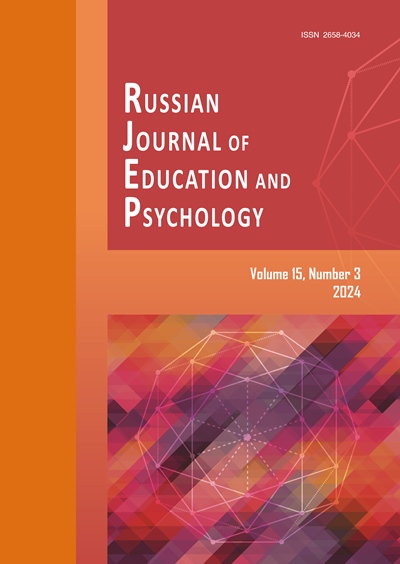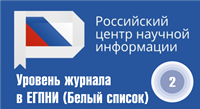ПЕРЕВЕРНУТЫЙ КЛАСС КАК СПОСОБ КОМПЕНСАЦИИ НЕДОСТАТОЧНОГО УРОВНЯ ВЛАДЕНИЯ ИНОСТРАННЫМ ЯЗЫКОМ У АСПИРАНТОВ
Аннотация
Обоснование. Переход на новые стандарты в российском образовании привел к определенным изменениям на постдипломном уровне высшего образования. Особенно остро эта проблема коснулась аспекта преподавания иностранного языка в аспирантуре. В частности, в Самарском государственном экономическом университете были отменены вступительные экзамены по иностранному языку, а объем занятий максимально ограничен. Тем не менее, уровень требований к выпускным экзаменам остается достаточно высоким. Актуальность статьи обусловлена необходимостью поисков возможного решения проблемы, связанной с низким уровнем предшествующей языковой подготовки определенной категории аспирантов.
Цель – оценка эффективности стратегии «перевернутый класс» как способа компенсации недостаточного уровня владения английским языком у аспирантов неязыкового вуза.
Материалы и методы. «Перевернутый класс» представляет собой подход, хорошо зарекомендовавший себя на других уровнях образования. В данной статье представлены результаты констатирующего эксперимента. Методология исследования основана на анализе потребностей, статистических расчетах и контент-анализе интервью студентов. Аспиранты, чьи потребности в повышении уровня владения языком были определены на первом этапе эксперимента, затем приняли участие в эксперименте «перевернутый класс».
Результаты. Результаты эксперимента доказывают эффективность предложенного формата обучения аспирантов в неязыковом вузе, поскольку он позволяет достичь уровня знаний, достаточного для успешной сдачи экзамена. Сделаны выводы о том, что данный подход может стать эффективным средством преодоления проблем, с которыми сталкиваются сегодня преподаватели и студенты постдипломного образования.
Скачивания
Литература
References
Agirman N., Ercoskun M.H. History of the flipped classroom model and uses of the flipped classroom concept. International Journal of Curriculum and Instructional Studies, 2022, vol. 12, no.1, pp. 78-88.
Aikina T.Y., Sumtsova O.V., Pavlov D.I. Implementing electronic courses based on Moodle for foreign language teaching at Russian technical universities. International Journal of Emerging Technologies in Learning, 2015, vol. 10, no. 3, pp. 58-67.
Almazova N.I. et al. Analysis of some “fashionable” cognitive strategies in higher education pedagogy. Bulletin of Tambov University. Series: Humanities, 2024, vol. 28, no. 4, pp. 813-832. http://doi.org/10.20310/1810-0201-2023-28-4-813-832
Baker J. The classroom flip: Becoming the guide by the side, 2000, http://works.bepress.com/j_wesley_baker/5/ (accessed September 7, 2023).
Bergmann J., Sams A. Flipping for mastery, 2014, vol. 71, no.4, pp. 24-29.
Borzova T. A. Teacher as a principle element of the “flipped classroom” technology. Higher Education in Russia, 2018, vol. 27, no. 5, pp. 42-49.
Cevikbas M., Kaiser G. Can flipped classroom pedagogy offer promising perspectives for mathematics education on pandemic-related issues? A systematic literature review. ZDM–Mathematics Education, 2023, vol. 55, no. 1, pp. 177-191.
Dumont A., Berthiaume D. La pédagogie inversée: Enseigner autrement dans le supérieur par la classe inversée. De Boeck Supérieur, 2016, https://www.researchgate.net/publication/311174066_La_Pedagogie_inversee (accessed June 27, 2023).
Fisher R., Tran Q., Verezub E. Teaching English as a Foreign Language in Higher Education using flipped learning/flipped classrooms: a literature review. Innovation in Language Learning and Teaching, 2024, pp. 1-20.
Gerstein J. The flipped classroom model: A full picture [EB/OL], 2012. https://usergeneratededucation.wordpress.com/2011/06/13/the-flipped-classroom-model-a-full-picture/ (accessed September 14, 2023).
Gorbunovs A., Kapenieks A., Cakula S. Self-discipline as a key indicator to improve learning outcomes in e-learning environment. Procedia-Social and Behavioral Sciences, 2016, vol. 231, pp. 256-262.
Kotova, E. G. A brief overview of the current state of the theory and practice of the “Flipped classroom” technology. For contribution to the development of modern education and pedagogical activity, 2024, p. 53.
Lejia L. I. U., Hew K. F., Du J. Design principles for supporting self-regulated learning in flipped classrooms: A systematic review. International Journal of Educational Research, 2024, vol. 124, pp. 102319.
Martynova I.A. Development of oral reading fluency in foreign language through a blended course in a non-linguistic university. Kazan Pedagogical Journal, 2020, vol. 1(138), pp. 128-135. http://doi.org/10.34772/KPJ.2020.138.1.018
Mazur E., Crouch C. H. Peer instruction: Ten years of experience and results. American journal of physics, 2001, vol. 69, no. 9, pp. 970-977.
Muldrow K. A new approach to language instruction: Flipping the classroom. The Language Educator, 2013, vol. 11, pp. 28-31.
Oxford R. Who are our students? A synthesis of foreign and second language research on individual differences with implications for instructional practice. TESL Canada Journal, 1992, pp. 30-49.
Pavelyeva T. Yu. Implementation of the “flipped classroom” technology based on the “YourStudy” platform. Bulletin of Tambov University. Series: humanities, 2017, vol. 22, no. 5 (169), pp. 82-87.
Tikhonova N.V. Technology "flipped classroom" in higher education: potential and problems of implementation. Kazan Pedagogical Journal, 2018, vol. 2 (127). pp. 74-78.
Polyakova T.Yu. The main directions of the development of the foreign language training system in non-linguistic universities. Bulletin of the Moscow State Linguistic University. Education and pedagogical sciences, 2019. vol.1 (830). pp. 77-83.
Sointu E. et al. Preliminary evidence of key factors in successful flipping: Predicting positive student experiences in flipped classrooms. Higher Education, 2023, vol. 85, no. 3, pp. 503-520.
Vitta J. P., Al-Hoorie A. H. The flipped classroom in second language learning: A meta-analysis. Language Teaching Research, 2023, vol. 27, no. 5, pp. 1268-1292.
Voronina M. V. «Flipped» class–innovative model of training. Open education, 2018, vol. 22, no. 5, pp. 40-51. http://dx.doi.org/10.21686/1818-4243-2018-5-40-51
Список литературы
Agirman N., Ercoskun M.H. History of the flipped classroom model and uses of the flipped classroom concept // International Journal of Curriculum and Instructional Studies, 2022, vol. 12, no.1, pp. 78-88.
Aikina T.Y., Sumtsova O.V., Pavlov D.I. Implementing electronic courses based on Moodle for foreign language teaching at Russian technical universities // International Journal of Emerging Technologies in Learning, 2015, vol. 10, no. 3, pp. 58-67.
Алмазова Н. И., Попова Н. В., Шипунова О. Д., Кузьмина А. В. Анализ некоторых "модных" познавательных стратегий в педагогике высшей школы // Вестник Тамбовского университета. Серия: Гуманитарные науки. 2023. Т. 28, № 4. С. 813-832. http://doi.org/10.20310/1810-0201-2023-28-4-813-832
Baker J. The classroom flip: Becoming the guide by the side, 2000. URL: http://works.bepress.com/j_wesley_baker/5/ (accessed September 07, 2023).
Bergmann J., Sams A. Flipping for mastery, 2014, vol. 71, no. 4, pp. 24-29.
Борзова T.A. Преподаватель как основное звено технологии "перевернутый класс"// Высшее образование в России. 2018. № 5. С.42-49.
Cevikbas M., Kaiser G. Can flipped classroom pedagogy offer promising perspectives for mathematics education on pandemic-related issues? A systematic literature review // ZDM–Mathematics Education, 2023, vol. 55, no. 1, pp. 177-191.
Dumont A., Berthiaume D. La pédagogie inversée: Enseigner autrement dans le supérieur par la classe inversée. De Boeck Supérieur, 2016. URL: https://www.researchgate.net/publication/311174066_La_Pedagogie_inversee (accessed June 27, 2023).
Fisher R., Tran Q., Verezub E. Teaching English as a Foreign Language in Higher Education using flipped learning/flipped classrooms: a literature review // Innovation in Language Learning and Teaching, 2024, pp. 1-20.
Gerstein J. The flipped classroom model: A full picture [EB/OL], 2012. URL: https://usergeneratededucation.wordpress.com/2011/06/13/the-flipped-classroom-model-a-full-picture/ (accessed September 14, 2023).
Gorbunovs A., Kapenieks A., Cakula S. Self-discipline as a key indicator to improve learning outcomes in e-learning environment // Procedia-Social and Behavioral Sciences, 2016, vol. 231, pp. 256-262.
Kotova E.G. A brief overview of the current state of the theory and practice of the “Flipped classroom” technology // For Contribution to the Development of Modern Education and Pedagogical Activity, 2024, p. 53.
Lejia L.I.U., Hew K.F., Du J. Design principles for supporting self-regulated learning in flipped classrooms: A systematic review // International Journal of Educational Research, 2024, vol. 124, pp. 102319.
Мартынова И. А. Развитие комплексного навыка беглого чтения вслух в рамках курса смешанного обучения иностранному языку в неязыковом вузе // Казанский педагогический журнал. 2020. № 1(138). С. 128-136. http://doi.org/10.34772/KPJ.2020.138.1.018
Mazur E., Crouch C.H. Peer instruction: Ten years of experience and results // American Journal of Physics, 2001, vol. 69, no. 9, pp. 970-977.
Muldrow K. A new approach to language instruction: Flipping the classroom // The Language Educator, 2013, vol. 11, pp. 28-31.
Oxford R. Who are our students? A synthesis of foreign and second language research on individual differences with implications for instructional practice // TESL Canada Journal, 1992, pp. 30-49.
Pavelyeva T.Yu. Implementation of the “flipped classroom” technology based on the “YourStudy” platform // Bulletin of Tambov University. Series: humanities, 2017, vol. 22, no. 5 (169), pp. 82-87.
Тихонова Н.В. Технология "перевернутый класс" в вузе: потенциал и проблемы внедрения // КПЖ. 2018. №2 (127). С. 74-78.
Полякова Т. Ю. Развитие подготовки по иностранному языку в неязыковых вузах в условиях реформирования высшего образования // Вестник Московского государственного лингвистического университета. Образование и педагогические науки. 2024. №2 (851). С. 77-83.
Sointu E. et al. Preliminary evidence of key factors in successful flipping: Predicting positive student experiences in flipped classrooms. Higher Education, 2023, vol. 85, no. 3, pp. 503-520.
Vitta J.P., Al-Hoorie A. H. The flipped classroom in second language learning: A meta-analysis. Language Teaching Research, 2023, vol. 27, no. 5, pp. 1268-1292.
Воронина М.В. "Перевёрнутый" класс – инновационная модель обучения // Открытое образование. 2018. №5. С. 40-51. http://dx.doi.org/10.21686/1818-4243-2018-5-40-51
Просмотров аннотации: 127
Copyright (c) 2024 Irina A. Martynova

Это произведение доступно по лицензии Creative Commons «Attribution-NonCommercial-NoDerivatives» («Атрибуция — Некоммерческое использование — Без производных произведений») 4.0 Всемирная.




































